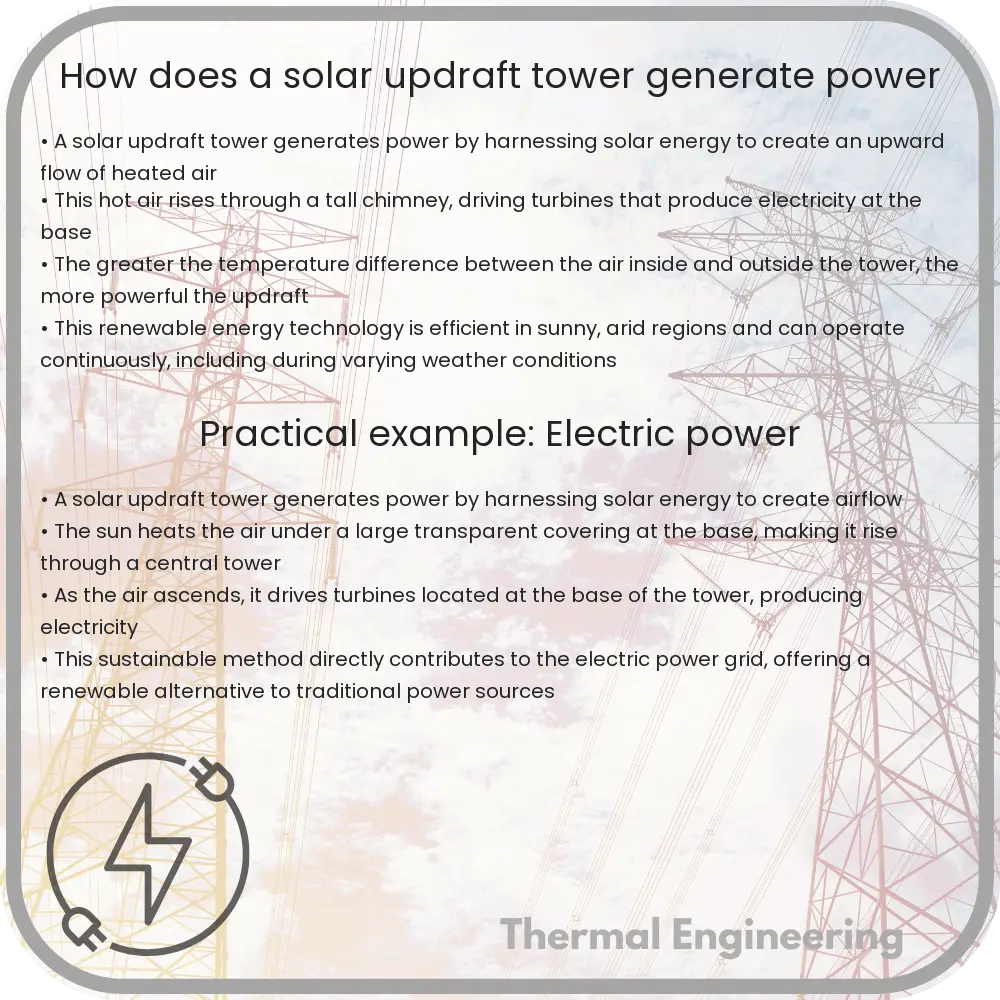Learn about solar updraft towers, an innovative renewable energy technology that combines solar and wind power to generate electricity efficiently.

Understanding the Energy Conversion in Solar Updraft Towers
Solar updraft towers (also known as solar chimneys) are a type of renewable energy technology that leverage both solar power and wind power to generate electricity. Simple yet effective, this technology is an intriguing testament to sustainable engineering principles. Let’s dive into how a solar updraft tower works and explores its potential in the field of green energy.
The Components of a Solar Updraft Tower
A solar updraft tower primarily consists of three parts:
- The Solar Collector: A large area of glass or plastic that acts as a greenhouse. This collector is built around the base of a central tower, capturing solar radiation and heating the air underneath.
- The Tower: Rising from the center of the collector, the tower acts as a chimney. Typically constructed from concrete or another material with strong thermal stability, the tower allows hot air to rise through it.
- Turbines: Positioned at the base of the tower, turbines are installed in openings where the tower meets the collector. As hot air rises through the tower, it passes through these turbines, generating electricity.
How It Generates Power
The operational principle of a solar updraft tower is grounded in the basic physics of heat and flow dynamics. Here’s the step-by-step process:
- Solar Heating: The sun’s rays heat the air beneath the collector canopy, significantly increasing its temperature. Because warm air is less dense than cooler air, it begins to rise.
- Updraft Creation: As the hot air is confined under the collector, it seeks a way to escape and naturally flows toward the tower, which provides a route to higher altitudes. The structural design of the tower promotes a strong upward draft.
- Energy Conversion: The rapidly rising warm air passes through turbines at the base of the tower. As the air pushes through the turbine blades, it causes them to spin, driving the turbine generators to produce electricity.
- Continuous Operation: As long as sunlight heats the air under the collector, and as long as the architecture supports the flow of air, the cycle continues, allowing for continuous power generation during sunlight hours.
Advantages and Limitations
Solar updraft towers offer several advantages:
- Renewable and Clean: They utilize solar energy, which is abundant and clean.
- Low Operating Costs: Once built, the operational and maintenance costs are relatively low compared to other power generation methods.
- Long Lifespan: Structures are generally robust and can last many years with proper maintenance.
However, there are some limitations:
- Large Land Area: A significant amount of land is required to accommodate the collector area.
- Initial Investment: The initial construction costs can be quite high due to the size of the structures needed.
- Efficiency: The overall efficiency of converting solar energy into electricity is lower compared to other technologies like photovoltaic cells.
The Future of Solar Updraft Towers
The potential for solar updraft towers in contributing to the renewable energy mix is significant, especially in sunny, arid regions where solar radiation is high and land may be less valuable. While not as widespread as solar panels or wind turbines, the unique benefits of solar updraft towers, particularly for areas with specific geographical and climatical advantages, keep them in consideration for future renewable energy projects.
By harnessing the simple physics of air movement and solar heating, solar updraft towers offer an intriguing option for sustainable power generation, showcasing how innovative engineering can convert natural processes into usable energy.